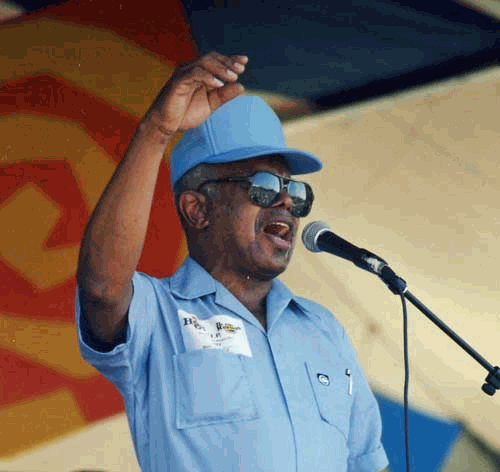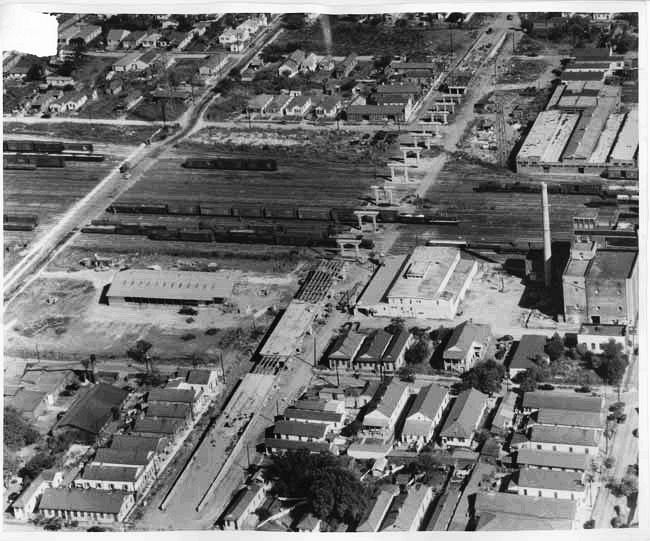|
Today in New Orleans History |
|
|
October 12

 To receive an update for each day in New Orleans history,
join our facebook page - Today in New
Orleans History.
 To receive an update for each day in New Orleans
history, join our facebook page
- Today in New Orleans History
Norman Treigle, born in New Orleans on March 6, 1927, made his operatic debut in
1947 with the New Orleans Opera Association, as the Duke of Verona in Roméo et Juliette.
A graduate of Loyola's College of Music, Treigle went on to receive international acclaim. He died in
New Orleans on February 16, 1975. On October 12, 2012, Treigle Plaza, at the Mahalia
Jackson Theater for the Performing Arts, was dedicated in his name.
The dedication ceremony preceded a Gala Concert by the New Orleans Opera starring Plácido Domingo with
Patricia Clarkson as hostess.
The caption for this photograph from the
New Orleans Public Library titled "North Claiborne Avenue Overpass: Union Station" reads "North Claiborne overpass
for Press Street yards of New Orleans and Northeastern railroad is nearing its final stages. The work was started April
1. It is only a few blocks away from sister-project, the North Galvez overpass. In addition to speeding flow of traffic,
overpasses and underpasses eliminate danger of rail crossing accidents. October 12, 1950". [Photography
by Industrial Aerial Photos] The oldest section of Claiborne Avenue runs through the
Tremé neighborhood where the wide neutral ground was lined with live oak trees, and the public green space served
as a center of congregation for the area's primariliy African-American residents. Lined with businesses with residential
neighborhoods throughout the adjacent blocks, it traditionally served as an important African-American shopping district,
a counterweight to Canal Street, which catered to the white community. The construction of the Interstate overpass
was wrought with controversy; The route mostly followed vacant land, such as the filled-in New Basin Canal but the original
design called for it to be built along the river through the French Quarter. A successful campaign was organized by French
Quarter residents and preservations to redirect that stretch of Interstate. The width of Claiborne Avenue provided the
second most convenient route for construction, while still bringing the interstate close to the Central Business District
and the French Quarter. The opposition of the largely African-American and disenfranchised residents of Treme was not enough
to stop the project from going forward. After construction, cement parking lots replaced the grassy neutral ground and
supports for the interstate replaced the old oak trees, permanently changing the streetscape. It is commonly held that
the construction of the overpass was intimately tied to the overall decline of the Treme neighborhood in the 60's and 70's
As part of the 2002
"Restore the Oaks" program, some of the support columns were painted by various local artists, while others were
painted to resemble oak trees. In the wake of Hurricane Katrina, many have called for the removal of the I-10 Claiborne
overpass, rerouting I-10 to the I-610 corridor. Supporters cite the structure's need for costly repairs and damage it has
caused and continues to cause to what could potentially be a thiving urban neighborhood. Opponents argue that the overpass'
removal would cause great inconvenience to the residents of New Orleans East and potentially require unwanted and intrusive
expansion of the I-610 corridor. The September 14th, 2009 draft of the New Orleans Master Plan calls for the study and eventual
removal of the overpass. Public meetings, private studies, plans, modeling scenarios, analyzing alternatives -- all
continue as of October 12, 2013 while the overpass remains and the Claiborne intersection at Orleans Avenue, in the heart
of Treme, remains a primary meeting ground for the Mardi Gras Indians. The London production of A Streetcar Named Desire, directed by Laurence Olivier, opened on October 12, 1949 and starred Bonar Colleano, Vivien Leigh, and Renee Asherson. Jazz trumpeter and the bandleader for the Preservation Hall Jazz Band,
John Brunious Jr. was born on October 12, 1940 to John "Picket"
Brunious, Sr., one of the founding fathers of jazz trumpeters in New Orleans, and Nazimova "Chinee" Santiago.
His younger brother, Wendell Brunious and later his nephew, Mark Braud, succeeded John as jazz trumpeters
and bandleaders of the Preservation Hall Jazz Band. He was a member of the Preservation Hall Jazz Band from 1980 until
his death at the age of 67 on February 12, 2008 in Orlando, Florida where he resided after the federal flood of 2005.
Jazz drummer Alfred "Tubby" Hal, born on October 12, 1895
in Sellers, Louisiana moved with his family to New Orleans
in his childhood. His younger brother Minor "Ram" Hall also became a professional drummer. He played in many marching
bands in New Orleans, including with Buddie Petit. In March 1917 Tubby Hall moved to Chicago and
played mostly with New Orleans bands; Carroll Dickerson's Orchestra (recording with it in 1927), King Oliver, Jimmie
Noone, Tiny Parham, Johnny Dodds, and Louis Armstrong. He can be seen in Armstrong's movies of the early 1930s, including
the live action and Betty Boop cartoon I'll Be Glad When You're Dead, You Rascal You
(1932) and A Rhapsody in Black and Blue (1932), made by Paramount.
Only Armstrong and Hall got closeups in the two films, and both get their faces transposed with those of racially stereotyped
"jungle natives" in the cartoon. Hall morphs from a jazz drummer to a cannibal stirring a cooking pot with two
wooden sticks. Noted swing and big-band drummer Gene Krupa said that Hall and Zutty Singleton "knew every trick and
just how to phrase the parts of the choruses behind the horns, how to lead a man in, what to do at the turn-arounds, when
to use sticks and when to use brushes, when to go for the rims or the woodblocks, what cymbals are for." Jazz
critic Hugues Panassié considered him one of the three greatest jazz drummers of his generation, along with Zutty Singleton
and Warren "Baby" Dodds.Tubby Hall died in Chicago on May 13, 1945.
|
|
|

To receive an update for each day in New Orleans history,
join our facebook page - Today in New
Orleans History.
Analytics |



